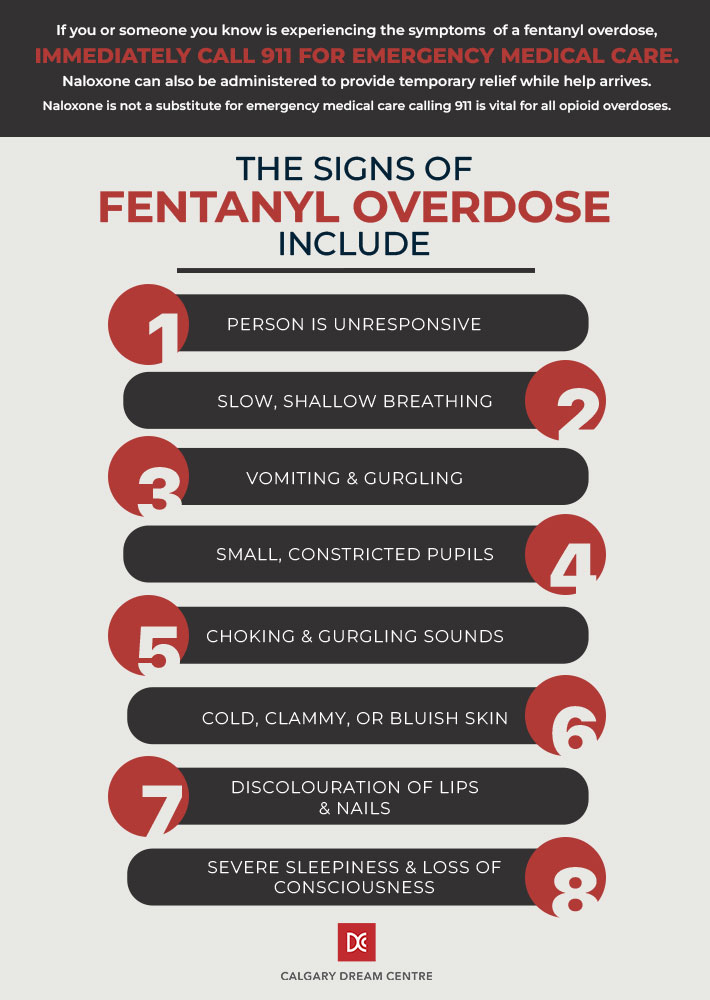The signs of a fentanyl overdose include:
- Person is unresponsive
- Slow, shallow breathing
- Vomiting
- Small, constricted pupils
- Choking & gurgling sounds
- Cold, clammy, or bluish skin
- Discolouration of lips & nails
- Severe sleepiness & loss of consciousness
If someone you know has taken opioids and is experiencing any of the symptoms listed above, it is vital to seek immediate assistance by calling 911. Naloxone can also be administered to temporarily block the effects of opioids while help arrives.
Substance use disorder is a complex health condition that requires understanding and support to aid recovery for men and women. Treating individuals with compassion and respect is essential for promoting healthy recovery journeys.
The rising number of tragedies caused by opioid overdoses is recognized by the Canadian government as a national public health crisis. Learning more about the risks associated with opioid use and how to respond during an overdose can help all of us contribute toward the health and wellness of those struggling with substance use disorders.
What to Do if You See the Signs of a Fentanyl Overdose
Fentanyl is a potent opioid that can cause life-threatening effects within 2 minutes of use, so responding quickly to the signs of an overdose is important.
Call 911
Call 911 to seek assistance from a public emergency department as soon as you see the signs of an overdose.
The Good Samaritan Drug Overdose Act provides some legal protection for those who experience an overdose and those who seek emergency help during an overdose. The legal protection granted by the act includes protection from:
- Charges for possession of a controlled substance under section 4(1) of the Controlled Drugs and Substances Act.
- Breach of conditions regarding simple possession of controlled substances in pre-trial release situations, probation orders, conditional sentences, and parole conditions.
When you call 911, remain calm and reassure the individual experiencing an overdose that help is on the way. Stay with the person to monitor their breathing, and try to keep them awake, breathing, and alert.
Turn the person on their side to prevent choking, and remain with them until help arrives. If their breathing slows considerably or their symptoms worsen, it may be necessary to administer naloxone.
Administer Naloxone
Naloxone can be administered as a nasal spray and as an injectable. Free naloxone kits and training are available at over 2,000 sites in Alberta and can be acquired anonymously.
Opioids like fentanyl, heroin, morphine, and codeine can interrupt a person’s breathing. Naloxone works by disrupting and blocking opioid receptors in the brain to reverse the effects of opioids on a person’s body.
When administered correctly, naloxone can take effect in 2-3 minutes and restore a person’s breathing in 2-5 minutes—but the effects are temporary. Naloxone lasts for 20-90 minutes, but the effects of opioids can last longer, so it may be necessary to re-administer naloxone if a person’s condition begins to worsen again before help arrives.
It is important to remember that naloxone is not a substitute for emergency medical care. You should still call 911 after administering naloxone.

What Is Fentanyl & Why Is it Dangerous?
Fentanyl is a pain reliever that can be prescribed by doctors and is usually reserved for use in medical settings in the form of tablets, injections, and patches.
Just a few grains of fentanyl are enough to cause life-threatening effects—it is extremely potent, and the risk of experiencing an overdose in a non-medical setting is very high. Fentanyl is 20-40 times more potent than heroin and 100 times more potent than morphine.
In addition to its potency, there are a number of reasons why fentanyl is considered to be dangerous, including:
- It is odourless and tasteless, so it is possible to ingest fentanyl without knowing it.
- Fentanyl can be mixed with other substances, and the risk of an overdose can increase when fentanyl is mixed with alcohol, benzodiazepines, or other opioids.
Short-Term Effects of Fentanyl Use
Fentanyl can cause people to drift in and out of consciousness and can result in several additional mental and physical effects, including:
- Dizziness
- Confusion
- Drowsiness
- Slow breathing
- Nausea & vomiting
- Itchiness & warm sensations on a person’s skin
- Small, constricted pupils

Risks Associated with Fentanyl Use
Those who take opioids for non-medical purposes or do not take opioids exactly as prescribed face several risks associated with overuse, not least of which is the increased risk of a life-threatening overdose.
Additional risks include:
Withdrawal Symptoms
Physical dependence and substance use disorder can develop within weeks of continued fentanyl use, and withdrawal symptoms are a common challenge for many people affected by this form of opioid addiction.
Common withdrawal symptoms include:
- Anxiety
- Nausea
- Insomnia
- A racing heartbeat
- Abdominal cramping
- Vomiting & diarrhea
- Sweating & cold flashes
- Restlessness
- Depression
- Intense cravings for the substance causing withdrawal
Pregnancy Risks & Complications
Fentanyl can pose serious risks for individuals who take fentanyl while pregnant, as well as their children, including:
- Miscarriage
- Low birth weight
- Premature delivery
Opioid use can also have adverse effects on the newborn children of individuals who take fentanyl while pregnant, including withdrawal symptoms. A newborn affected by fentanyl withdrawal may experience:
- Sweating
- Irritability
- Trouble feeding
- Excessive crying
- Shaky & jerky movements
- Diarrhea
- Vomiting
The effects of fentanyl withdrawal can be life-threatening for newborn children. Hospital treatment is strongly recommended to support the health and recovery of newborns affected by opioid use during pregnancy.
Long-Term Effects of Fentanyl Use
Unfortunately, the long-term effects of pharmaceutical opioids have not been fully studied. However, there are several long-term effects that have been observed through real-world experiences, including:
- Substance use disorder
- Depression & suicidal thoughts
- Difficulty in controlling impulsive behaviour
- Constipation
- Poor nutrition
- Weight loss
- Irregular menstrual cycles
Support for Substance Use Disorders & Homelessness
Seeking treatment is the first step toward recovering from substance use disorder related to opioids and other substances that can affect a person’s physical health, mental health, and family life.
From addiction recovery programs to support for more complicated goals like reconnecting with family after addiction, the Calgary Dream Centre is here to help individuals affected by substance use disorder and homelessness.
Speak with us to learn more about how we strive to support individuals as they take steps towards recovery and a new, purposeful life.



